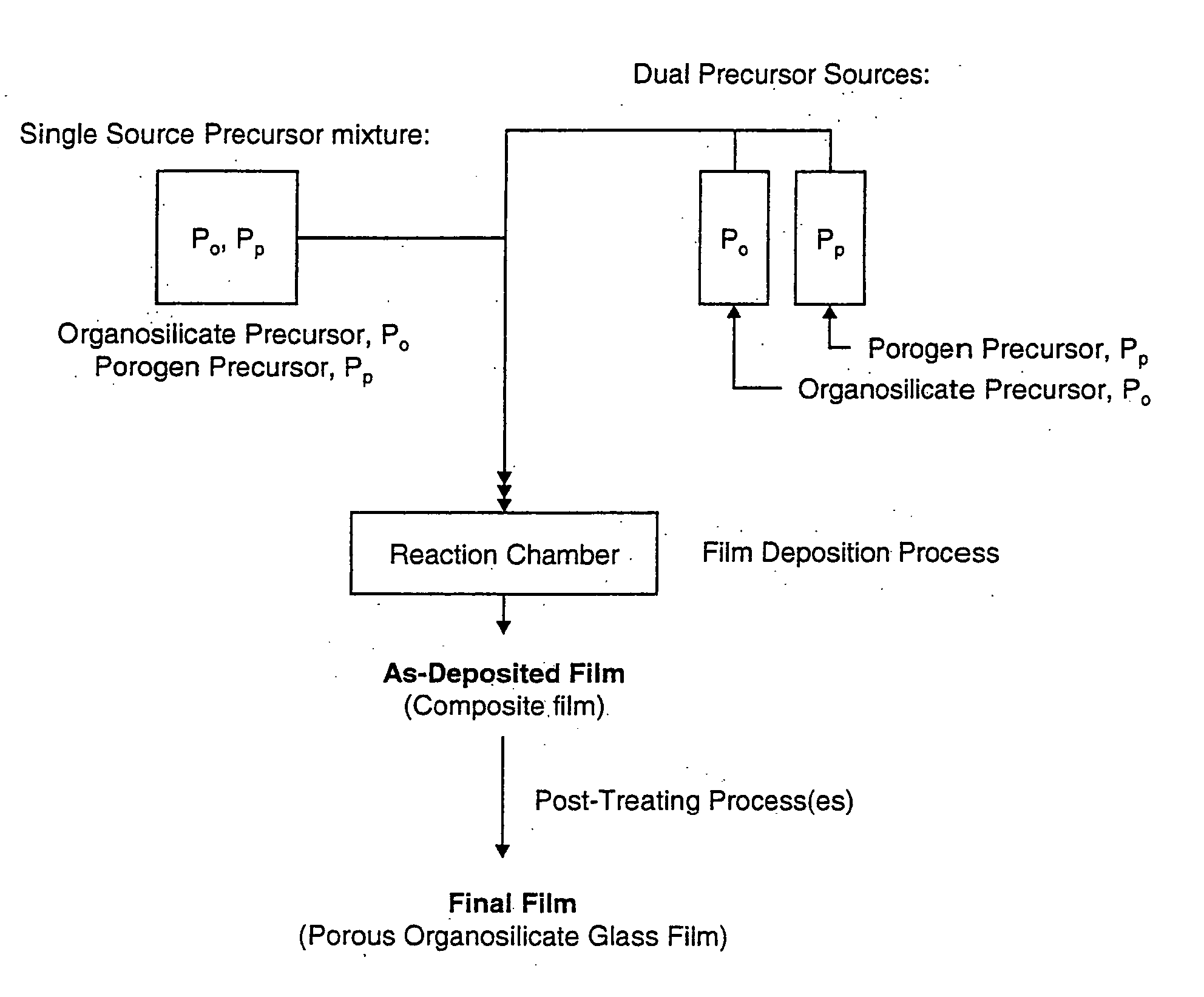Porous low dielectric constant compositions and methods for making and using same
- Summary
- Abstract
- Description
- Claims
- Application Information
AI Technical Summary
Benefits of technology
Problems solved by technology
Method used
Image
Examples
example 1
Variation of the Porogen Precursor to Silicon-Containing Precursor Stoichiometry
[0136] Composite films were deposited from a mixture of cyclohexanone (CHO) and diethoxymethylsilane (DEMS). The deposition conditions were as follows: the plasma power was 450 Watts, reaction chamber pressure was 8 torr, electrode spacing was 350 milli-inches, carrier gas was Helium at a flow rate of 210 sccm, and the substrate temperature was 225° C. The CHO and DEMS flow rates were varied to control the ratio of CHO and DEMS introduced into the reaction chamber, while leaving constant the overall flow rate of chemical into the chamber. The films were post-treated by exposing them to broadband UV light (λ=200-400 nm) under vacuum for 5 minutes.
TABLES 1a and 1bAs-deposited and final film properties, respectively, for films depositedusing cyclohexanone and DEMS.CHO flowDEMS flowTotal FlowCHO:DEMSDepositionRefractive Index(mg / min)(mg / min)(mg / min)ratioRate (nm / min)(As Dep'd)4501506004.102001.48040020060...
example 2
Porogen Precursor Functional Groups
[0138] The structure and / or composition of the porogen precursor may also be used to control the film properties. Composite films were deposited from CHO or 1,2,4-trimethylcyclohexane (TMC). Table 2 compares the neat liquid properties of these precursors. The CHO precursor consists of a 6 carbon ring with a ketone functional group, while the TMC precursor has a 6 carbon ring with three methyl groups attached at the 1, 2, and 4-positions.
TABLE 2Properties of neat liquid porogen precursors.H / CMolecularDensityRefractiveBoilingPorogen PrecursorFormularatioWeight(g / mL)IndexPoint (° C.)Cyclohexanone (CHO)C6H10O1.6798.150.9471.4501551,2,4-Trimethylcyclohexane (TMC)C9H182.0126.240.7861.433141-143
[0139] The deposition conditions for composite films deposited from TMC and DEMS, or CHO and DEMS are detailed in Table 3. The film deposited using the CHO precursor has a higher deposition rate and as-deposited refractive index, suggesting that there is a highe...
example 3
[0142] Composite films were deposited from a mixture of cyclohexanone (CHO) and diethoxymethylsilane (DEMS) in a 22 / 78 by mole percent ratio. The deposition conditions were as follows: the plasma power was 600 Watts, reaction chamber pressure was 8 torr, electrode spacing was 350 milli-inches, carrier gas was CO2 at a flow rate of 200 sccm, additive gas was O2 at a flow rate of 10 sccm, the deposition rate was 450 nanometers (nm) per minute, and the substrate temperature was 250° C. The CHO and DEMS flow rates were varied to control the ratio of CHO and DEMS introduced into the reaction chamber while leaving constant the overall flow rate of chemical into the chamber. The films were post-treated by exposing them to broadband UV light (λ=200-400 nm) under vacuum for 5 minutes and the percentage of shrinkage was 30%. Various characteristics of the as-deposited and final film after exposure to UV treatment is provided in Table 5.
[0143]FIG. 4 shows the FT-IR spectra of the DEMS / CHO fil...
PUM
| Property | Measurement | Unit |
|---|---|---|
| Temperature | aaaaa | aaaaa |
| Fraction | aaaaa | aaaaa |
| Fraction | aaaaa | aaaaa |
Abstract
Description
Claims
Application Information
 Login to View More
Login to View More - R&D
- Intellectual Property
- Life Sciences
- Materials
- Tech Scout
- Unparalleled Data Quality
- Higher Quality Content
- 60% Fewer Hallucinations
Browse by: Latest US Patents, China's latest patents, Technical Efficacy Thesaurus, Application Domain, Technology Topic, Popular Technical Reports.
© 2025 PatSnap. All rights reserved.Legal|Privacy policy|Modern Slavery Act Transparency Statement|Sitemap|About US| Contact US: help@patsnap.com



